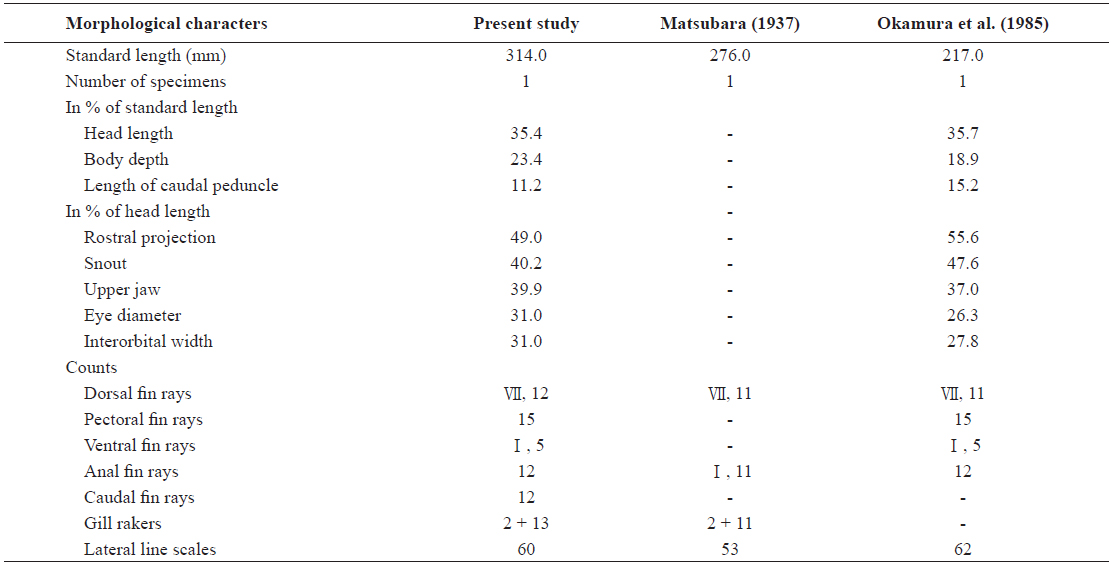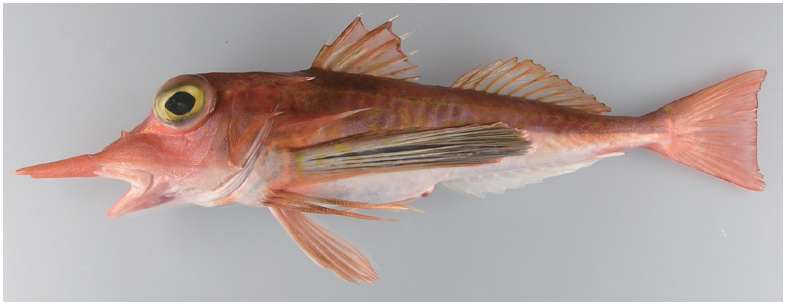



The searobins or gurnards (family Triglidae) are mediumsized benthic fishes typically less than 45 cm in total length, and inhabit tropical and temperate seas to depths of about 200 m (Fischer and Bianchi 1984). They include 10 genera with approximately 105 species worldwide (Nelson, 2006) and three genera with 10 species in Korea (Kim et al., 2005).
The genus
Recently, one specimen of
The specimen was preserved in 10% formalin for one week and then transferred to 70% ethanol. Counts and measurements followed the methods of Hubbs and Lagler (1964) and Richards et al. (2003). The specimen was deposited at the Fish Genetics and Breeding Laboratory of Jeju National University (JNU), Korea.
>
Pterygotrigla multiocellata (
[Table 1.] Comparison of morphological characters of Pterygotrigla multiocellata

Comparison of morphological characters of Pterygotrigla multiocellata
(New Korean name: Gin-ppul-mit-seong-dae)
JNU-1308, 314.0 mm standard length (SL), caught with a gill net off south Seogwipo, Jeju Island, Korea, 11 February 2010.
Table 1 lists the counts and measurements of the morphological traits of the specimen. Counts are as follows: dorsal fin rays, Ⅶ, 12; anal fin rays, 12; pectoral fin rays, 15; ventral fin rays, Ⅰ, 5; caudal fin rays, 12; lateral line scales, 60; gill rakers, 2+13. Measurements as a percentage of SL are as follows: body depth, 23.4; head length, 35.4; upper jaw length, 14.1; snout length, 14.2; interorbital width, 11.0; eye diameter, 11.0; length of rostral spine, 17.3; first predorsal fin length, 40.0; second predorsal fin length, 65.1; prepectoral fin length, 34.0; preanal fin length, 62.1; preventral fin length, 33.0; first dorsal fin base length, 20.4; second dorsal fin base length, 24.9; pectoral fin base length, 7.2; anal fin base length, 29.6; ventral fin base length, 4.7; length of longest dorsal fin ray, 15.1; length of longest pectoral fin ray, 46.0; length of longest ventral fin ray, 24.5; caudal peduncle length, 11.2; caudal peduncle depth, 5.4. Measurements as a percentage of head length (HL) are as follows: snout length, 40.2; upper jaw length, 39.9; eye diameter, 31.0; interorbital width, 31.0; length of rostral spine, 49.0.
Body elongated; anterior body large, became smaller backward; head and caudal triangular; head large without scales; eye large and projected outside, located above head; no spines around orbit; rostral spine very long; a pair of nasal spines located at middle of snout; preopercle and opercular spines short; nuchal spine long and sharp, almost reaching to base of second dorsal fin; mouth size almost the same as eye diameter; vomer with a patch of villiform teeth; interorbital space somewhat deeply concave; cleithral spine very long, arriving nearly to base of sixth dorsal fin; base of first dorsal fin with ten large and smooth flat plates; pectoral fin very long, with three lowermost rays free and detached from the remaining fin rays.
Body overall reddish with sparse small yellow and green spots on upper half; belly and below head white; pectoral fin black with greenish yellow blotched pattern, except white part of bone; detached pectoral fins dark reddish; dorsal fins reddish with small green spots; ventral and caudal fins reddish; anal fin white.
Head and dorsal part of body brown but white ventrally; pectoral fin black except white part of bone; detached pectoral fins white; all fins white; indistinct and pale spots present on upper half.
Known from the Western Pacific: New Caledonia (Del Cerro and Lloris, 1997), Mariana Island (Myers and Donaldson, 2003), the South China Sea (Randall and Lim, 2000), Japan (Matsubara, 1937; Yamada, 2002) and Korea (Jeju Island, present study).
The present specimen, collected from the coastal waters of Korea, agrees well in its morphological characters with previous reports on

